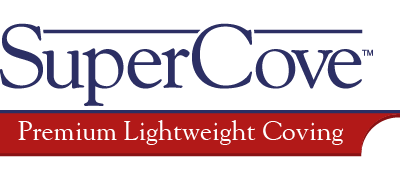Best Alternative to Polystyrene Coving – Why Polyurethane is the Smarter Choice
When it comes to finishing a room, coving is often the element that makes the difference between a space that feels complete and one that looks unfinished. But if you’ve been browsing your local DIY store or searching online, chances are you’ve come across polystyrene coving. It’s cheap, it’s light, and it promises quick results.
So why do so many homeowners regret using it?
The truth is that while polystyrene may look like a bargain, its poor durability and flimsy finish often leave renovators wishing they had chosen something better. That’s where polyurethane lightweight coving comes in – particularly from trusted UK manufacturers like Supercove.
In this article, we’ll unpack the drawbacks of polystyrene, explore the best alternatives, and show you why polyurethane is the smarter, longer-lasting choice for your home.
What Is Polystyrene Coving?
Polystyrene coving is made from expanded polystyrene foam – the same material used for packaging and disposable cups. It’s lightweight, easy to cut with a knife, and inexpensive. Because of this, many homeowners are drawn to it as a quick, budget-friendly way to add decorative detail to ceilings.
Perceived benefits of polystyrene coving include:
- Very low cost compared with other materials.
- Extremely light and easy to handle.
- Can be cut without specialist tools.
On the surface, it seems like a no-brainer for DIY projects. But does it live up to expectations?
The Common Issues with Polystyrene Coving
Unfortunately, the disadvantages of polystyrene coving quickly become apparent once you start working with it or living with it.
1) Durability Concerns
Polystyrene is soft and fragile. It dents if you press too hard during installation and can crumble at the edges when cut. Even after it’s up, it’s prone to knocks and damage from everyday living.
2) Appearance
Polystyrene simply doesn’t offer the crisp detail of other materials. Once painted, it often still looks cheap, with visible grain or an uneven surface. For homeowners who want a professional finish, this is a major drawback.
3) Longevity
Because it damages easily, polystyrene coving often needs replacing far sooner than alternatives. A low initial cost can become a false economy when you have to redo the work within a few years.
4) Environmental Factor
Polystyrene is a petroleum-based plastic foam, notoriously difficult to recycle. Choosing it for your home means opting for a less sustainable material.
Exploring the Alternatives
If polystyrene is disappointing, what else is out there?
Plaster Coving
The traditional choice, plaster coving is strong, authentic, and capable of incredibly detailed designs. However, it’s heavy, messy to install, and significantly more expensive. It also requires skilled tradespeople, making it less DIY-friendly.
Wooden Coving
Less common today, wooden coving can add warmth and character. But it’s vulnerable to warping in humidity and doesn’t always suit modern interiors.
Polyurethane Lightweight Coving
The modern solution that’s become the go-to for UK homeowners. Polyurethane combines the best of both worlds: the crisp detail of plaster and the practicality of lightweight materials. It’s strong, durable, and easy to install – making it the clear best alternative to polystyrene coving.
Why Polyurethane Lightweight Coving Is the Best Alternative
Here’s what makes polyurethane – and specifically Supercove’s range – so effective:
Strength & Durability
Unlike polystyrene, polyurethane is dense and impact-resistant. It doesn’t dent at the slightest touch, and once installed, it stands up to everyday knocks and scrapes.
Crisp Detail
Supercove’s polyurethane coving profiles are moulded with precision, offering sharp edges and elegant contours that rival traditional plaster. Painted in place, it’s virtually indistinguishable from plasterwork.
Moisture Resistance
Unlike wood or plaster, polyurethane won’t warp, crack, or deteriorate in humid environments. This makes it ideal for bathrooms, kitchens, and utility rooms.
Easy Installation
Polyurethane can be cut with a simple saw and installed with adhesive – no special tools or trades required. It’s the perfect DIY option for fast, tidy results.
Range of Styles
Whether you prefer understated modern profiles or ornate designs inspired by period architecture, polyurethane offers a wide selection to suit every property. Many profiles are ready to paint.
Eco-Friendly Advantages
Polyurethane is more sustainable than polystyrene. Being lightweight, it reduces carbon emissions during transport. Choosing a UK manufacturer like Supercove also cuts down on overseas shipping miles while supporting local jobs.
Why Supercove
Supercove is a UK-based manufacturer with a strong reputation for quality and reliability. Their polyurethane coving is widely available across the country, making it easy for homeowners to choose a home-grown, trusted product.
Polystyrene vs Polyurethane: A Side-by-Side Comparison
To make the difference clear, here’s how polystyrene stacks up against polyurethane:
| Feature | Polystyrene Coving | Polyurethane Coving (Supercove) |
|---|---|---|
| Durability | Soft, dents easily, prone to damage | Strong, impact-resistant, long-lasting |
| Appearance | Basic, grainy finish | Crisp, plaster-like detail |
| Installation | Easy, but edges crumble when cut | Easy DIY with saw and adhesive |
| Moisture Resistance | Poor | Excellent – suitable for kitchens & bathrooms |
| Longevity | Short lifespan, often needs replacing | Long-term solution |
| Eco-Friendliness | Petroleum-based, poor recyclability | Lightweight transport, UK-made option |
| Cost | Cheapest upfront | Slightly higher initial cost, far better value over time |
Customer Experience: Upgrading from Polystyrene to Supercove
Consider James, a homeowner from Leeds. He first fitted polystyrene coving in his living room to save money. Within a year, he noticed dents, gaps at the joins, and an overall “unfinished” look that didn’t match his newly decorated space.
Frustrated, he replaced it with Supercove polyurethane coving. The installation took him a weekend, and the result was a crisp, professional-looking finish that instantly elevated his interior. James now says he wishes he’d chosen polyurethane from the start – saving time, money, and disappointment.

How to Choose the Right Coving for Your Home
- Budget: While polystyrene is cheapest upfront, polyurethane offers far better value in the long run.
- Room Conditions: Bathrooms and kitchens need moisture-resistant materials like polyurethane.
- Property Style: Period homes may require ornate designs, which polyurethane can replicate beautifully.
- Installation Preference: If you’re a DIYer, polyurethane gives you professional results with minimal fuss.
- Longevity: Consider not just the upfront cost but how long the product will last before needing replacement.
Installation Made Simple: Why DIYers Prefer Supercove
- Measure & plan: Calculate lengths and mark walls for joins and mitres.
- Cut to size: Use a mitre box and fine-tooth handsaw for clean, accurate angles.
- Apply adhesive: A quality coving adhesive creates a strong, clean bond.
- Press & secure: Offer up the piece, press firmly and wipe away excess.
- Finish & paint: Caulk any fine gaps, lightly sand if needed, and paint to match your scheme.
No wet trades, no specialist tools, and far less mess – just a crisp, professional finish in a fraction of the time.
Conclusion: The Clear Winner
Polystyrene coving may be tempting, but it rarely delivers lasting satisfaction. Its fragility, poor appearance, and environmental drawbacks make it a false economy for most homeowners.
By contrast, polyurethane lightweight coving from Supercove combines strength, crisp detailing, moisture resistance, and ease of installation. It offers everything polystyrene lacks – and more.
So, the next time you’re weighing up your options, ask yourself: Do you want coving that looks temporary and fragile, or one that adds genuine style and value to your home for years to come?
Next step: Explore Supercove’s full range of polyurethane lightweight coving and make the smarter choice for your home.



